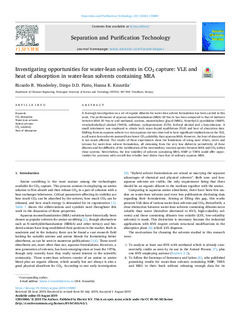| dc.contributor.author | Wanderley, Ricardo Ramos | |
| dc.contributor.author | Pinto, Diego Di Domenico | |
| dc.contributor.author | Knuutila, Hanna K | |
| dc.date.accessioned | 2019-08-20T07:20:43Z | |
| dc.date.available | 2019-08-20T07:20:43Z | |
| dc.date.created | 2019-08-19T14:25:30Z | |
| dc.date.issued | 2020 | |
| dc.identifier.issn | 1383-5866 | |
| dc.identifier.uri | http://hdl.handle.net/11250/2609245 | |
| dc.description.abstract | A thorough investigation on a set of organic diluents for water-lean solvent formulation has been carried in this work. The performance of aqueous monoethanolamine (MEA) 30 %w/w has been compared to that of mixtures between MEA 30 %w/w and methanol, acetone, monoethylene glycol (MEG), N-methyl-2-pyrrolidone (NMP), tetrahydrofurfuryl alcohol (THFA), sulfolane, cyclopentanone (CC5), furfuryl alcohol and γ-butyrolactone. A small calorimeter was employed to obtain both vapor–liquid equilibrium (VLE) and heat of absorption data. Shifting from an aqueous solvent to a non-aqueous one was observed to have significant implications on the VLE, as all water-lean solvents assessed have lower CO2 solubility than aqueous MEA. However, the heat of absorption is not much affected. The results of these experiments show the limitations of using most ethers, esters and ketones for water-lean solvent formulation, all stemming from the very low dielectric permittivity of these diluents and the difficulty of the stabilization of the intermediary reaction species between MEA and CO2 within these systems. Nevertheless, the low volatility of solvents containing MEG, NMP or THFA could offer opportunities for processes with overall less reboiler heat duties than that of ordinary aqueous MEA. | nb_NO |
| dc.language.iso | eng | nb_NO |
| dc.publisher | Elsevier | nb_NO |
| dc.rights | Attribution-NonCommercial-NoDerivatives 4.0 Internasjonal | * |
| dc.rights.uri | http://creativecommons.org/licenses/by-nc-nd/4.0/deed.no | * |
| dc.title | Investigating opportunities for water-lean solvents in CO2 capture: VLE and heat of absorption in water-lean solvents containing MEA | nb_NO |
| dc.type | Journal article | nb_NO |
| dc.type | Peer reviewed | nb_NO |
| dc.description.version | publishedVersion | nb_NO |
| dc.source.volume | 231 | nb_NO |
| dc.source.journal | Separation and Purification Technology | nb_NO |
| dc.identifier.doi | 10.1016/j.seppur.2019.115883 | |
| dc.identifier.cristin | 1717121 | |
| dc.description.localcode | © 2019 The Authors. Published by Elsevier B.V. This is an open access article under the CC BY-NC-ND license (http://creativecommons.org/licenses/BY-NC-ND/4.0/). | nb_NO |
| cristin.unitcode | 194,66,30,0 | |
| cristin.unitname | Institutt for kjemisk prosessteknologi | |
| cristin.ispublished | true | |
| cristin.fulltext | original | |
| cristin.qualitycode | 1 | |

